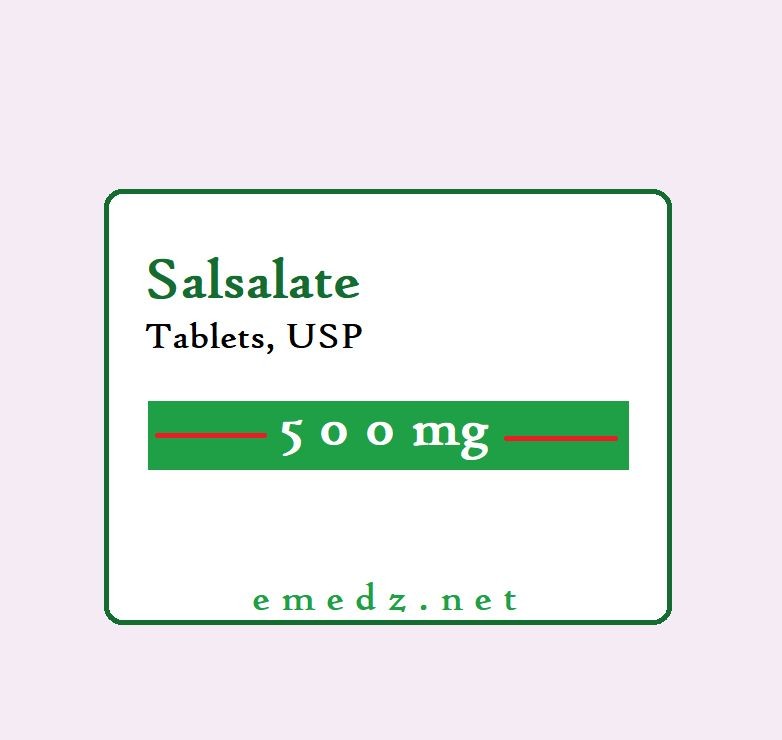
Contents
- 1 salsalate
- 1.0.1 What brand names are available for salsalate?
- 1.0.2 Is salsalate available as a generic drug?
- 1.0.3 Do I need a prescription for salsalate?
- 1.0.4 What are the side effects of salsalate?
- 1.0.5 What is the dosage for salsalate?
- 1.0.6 Which drugs or supplements interact with salsalate?
- 1.0.7 Is salsalate safe to take if I’m pregnant or breastfeeding?
- 1.0.8 What else should I know about salsalate?
- 1.0.9 Summary
- 1.0.10 Related Disease Conditions
- 1.1 Hip Bursitis
- 1.2 Rheumatoid Arthritis (RA)
- 1.3 Knee Pain
- 1.4 Osteoarthritis (OA)
- 1.5 Arthritis (Joint Inflammation)
- 1.6 Foot Pain
- 1.7 Bursitis
- 1.8 Ankle Pain (Tendonitis)
- 1.9 Knee Bursitis
- 1.10 Shoulder Bursitis
- 1.11 Nonsteroidal Anti-inflammatory Drugs and Ulcers
salsalate
Salsalate is a nonsteroidal anti-inflammatory drug (NSAID) used to treat fever, pain, and inflammation. Salsalate is converted to salicylic acid, its active form. Other NSAIDs include ibuprofen, indomethacin, nabumetone, and naproxen, among others. They work by reducing prostaglandin levels, chemicals that cause pain, fever, and inflammation. Salsalate blocks the enzyme that produces prostaglandins, resulting in lower concentrations and reduced inflammation, pain, and fever. Salsalate is as effective as aspirin in reducing inflammation, but has fewer effects on blood clotting.
What brand names are available for salsalate?
Amigesic, Salflex, Argesic-SA, Marthritic, Salsitab, Artha-G
Is salsalate available as a generic drug?
GENERIC AVAILABLE: Yes
Do I need a prescription for salsalate?
What are the side effects of salsalate?
Salsalate and other NSAIDs have few side effects in most patients. However, serious side effects can occur and are more common at higher doses. To minimize side effects, it is recommended to use the lowest effective dose. The most common side effects of salsalate are gastrointestinal issues and tinnitus. It can cause stomach and intestinal ulcers, abdominal pain, cramping, nausea, vomiting, gastritis, gastrointestinal bleeding, and liver toxicity. Sometimes, ulceration and bleeding can occur without abdominal pain. Other side effects include rash, kidney impairment, vertigo, lightheadedness, fluid retention, blood clots, heart attacks, high blood pressure, and heart failure.
What is the dosage for salsalate?
The usual dose of salsalate is 3000 mg daily, divided into 2-4 doses. Salsalate should be taken with food to reduce stomach upset.
Which drugs or supplements interact with salsalate?
Combining aspirin with salsalate can cause salicylic acid toxicity.
NSAIDs may increase blood levels of lithium, leading to toxicity.
NSAIDs may reduce the blood pressure-lowering effects of blood pressure medications.
When combined with methotrexate or aminoglycoside antibiotics, NSAIDs may increase blood levels of these drugs, leading to more side effects.
Individuals taking oral blood thinners or anticoagulants should avoid NSAIDs to prevent excessive blood thinning and bleeding.
People who consume more than 3 alcoholic beverages per day are at increased risk of developing stomach ulcers when taking NSAIDs.
Is salsalate safe to take if I’m pregnant or breastfeeding?
There are no adequate studies of salsalate in pregnant women.
Salicylic acid appears in breast milk at levels close to maternal blood levels. Nursing women should avoid nursing while taking salsalate or use alternate drugs.
What else should I know about salsalate?
What preparations of salsalate are available?
Tablets: 500 and 750 mg
How should I keep salsalate stored?
Salsalate should be stored at room temperature, 15 C (59 F – 86 F).
Drugs That Slow
RA’s Progress
Summary
Salsalate is a nonsteroidal anti-inflammatory medication used for the treatment of osteoarthritis, rheumatoid arthritis, soft tissue injuries, bursitis, and tendinitis. It may cause side effects such as gastrointestinal issues and tinnitus. Before taking this medication, it is important to review side effects, drug interactions, warnings and precautions, and safety during pregnancy.
Related Disease Conditions
Hip Bursitis
Hip bursitis results from inflammation of the fluid-filled sac near the hip due to localized soft tissue trauma or strain. Symptoms include stiffness and pain around the hip joint. Treatment options include rest, ice compresses, and anti-inflammatory and pain medications.
Rheumatoid Arthritis (RA)
Rheumatoid arthritis is an autoimmune disease that causes chronic inflammation in the joints and other organs. Symptoms include anemia, joint pain, swelling, stiffness, and limited range of motion. Early diagnosis and treatment are important to manage the disease.
Knee Pain
Knee pain can be caused by acute injuries, medical conditions, or chronic use conditions. Symptoms may include redness, swelling, difficulty walking, and locking of the knee. Diagnosis and treatment depend on the underlying cause.
Osteoarthritis (OA)
Osteoarthritis is a type of arthritis characterized by inflammation, breakdown, and loss of cartilage in the joints. It can be caused by aging, heredity, or injury.
Arthritis (Joint Inflammation)
Arthritis is inflammation of one or more joints, leading to symptoms such as joint pain, swelling, and stiffness. There are many types of arthritis, each with its own causes and treatment options.
Foot Pain
Foot pain can be caused by various factors, including injuries, diseases, viruses, fungi, bacteria, and ingrown toenails. Treatment options range from rest and ice compresses to over-the-counter medications for pain relief.
Bursitis
Bursitis is the inflammation of the fluid-filled sacs that cushion the joints. It can be caused by repetitive motion or bacterial infection. Treatment may involve rest, ice compresses, and antibiotics.
Ankle Pain (Tendonitis)
Ankle pain is commonly caused by sprains or tendinitis. The severity of ankle sprains varies, and treatment options include rest, ice compresses, and physical therapy. Tendinitis can be caused by trauma or inflammation.
Knee Bursitis
Knee bursitis occurs when the fluid-filled sacs near the knee become inflamed due to injury or strain. Symptoms include pain, swelling, warmth, tenderness, and redness. Treatment depends on whether infection is involved.
Shoulder Bursitis
Shoulder bursitis is the inflammation of the shoulder bursa, which can be caused by injury, infection, or rheumatic conditions. Symptoms include pain, swelling, tenderness, and limited shoulder joint movement.
Nonsteroidal Anti-inflammatory Drugs and Ulcers
NSAIDs such as aspirin, ibuprofen, and naproxen are prescribed for the treatment of inflammatory conditions. However, they can cause peptic ulcers. It is important to be aware of the side effects, drug interactions, warnings and precautions, and patient safety information when taking NSAIDs.
NSAIDs are prescribed medications for the treatment of inflammatory conditions. They can cause peptic ulcers, and it is important to be aware of the side effects and drug interactions when taking them.


